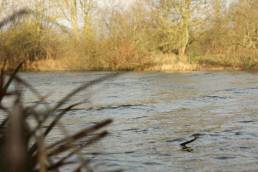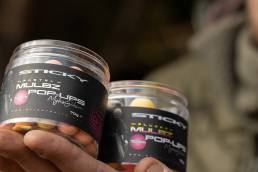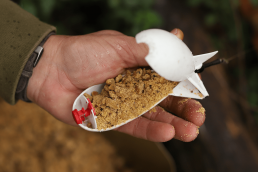JIM WILSON TALKS ABOUT HIS MINDSET WHEN IT COMES TO NEW VENTURES, AS HE TACKLES HIS WINTER TICKET WATER FOR THE FIRST TIME.
JIM WILSON TALKS ABOUT HIS MINDSET WHEN IT COMES TO NEW VENTURES, AS HE TACKLES HIS WINTER TICKET WATER FOR THE FIRST TIME.
The lake I’m fishing is a fairly large one by anyone’s standards, with a variety of depths and features, as it’s an old sandpit. The natural filtration through the lakebed means the water’s gin clear too, as well as being heavily populated with weed. Although this is great for spotting carp, it means your presentation has to be as close to perfect as possible, whilst using bait that will catch the carps’ attention.
Having built up a wealth of knowledge with a few feeler sessions, which included more mapping and planning than actual fishing, I was finally ready to give it a proper go. With the full moon approaching and info from the owner on how well the lake fishes, I knew I needed to put my previous knowledge into practice with a 48-hour session.

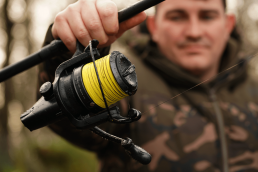
The area I’d mapped and found previously was a feature-packed part of the lake. It was in deep water with a variety of different lakebed substrates too, not only giving me options in terms of depths but what to present over as well. To the back of the area there was also a large dying weed bed, so it really did have it all.
On arrival, I had a rough idea on where I wanted to be from the previous leading up trips, and despite a few anglers being on the lake when I arrived, the area I fancied was free. Even though I was pretty happy with the swim, I dropped my water bottle in there and spent a few more hours looking and searching for the smallest of signs, just to make sure I’d not missed an opportunity, which could sway my swim choice. Information is so valuable at this time of the year, whether that’s patterns of captures with similar conditions or reverting back to previous years knowledge, nothing beats seeing the signs with your own eyes, and in my opinion that will always overshadow any pre-conceived ideas.
When it comes to fishing this time of the year, if the swim allows, I always vary the depths of my spots, as I believe it is a very important factor. By firstly using a marker setup to locate the various depths, I can paint a picture in my mind of the area out in front. In that particular swim, the weed was a big problem, so I switched to a grappler style lead. The metal prongs pick up the weed and help me ensure I am fishing on the cleanest part of the spot. If there’s still debris on the area, I always use a balanced pop-up to ensure my presentation is perfect. However, if it’s obviously clean, then I would go for a bottom bait or wafter.

"USING A PROLONGED LEAD TO DOUBLE CHECK THOSE SPOTS ARE CLEAR IS A GREAT TOOL, IT ALSO GIVES YOU EXTRA CONFIDENCE IN THE MAKE-UP OF THE LAKEBED."
"USING A PROLONGED LEAD TO DOUBLE CHECK THOSE SPOTS ARE CLEAR IS A GREAT TOOL, IT ALSO GIVES YOU EXTRA CONFIDENCE IN THE MAKE-UP OF THE LAKEBED."
I was far from convinced with this spot, it was clean, but not totally, so I opted to use a low-lying pop-up presentation. Just to ensure the hook didn’t get snarled up in any leaves or weed. After pulling the lead through the soft, sandy drop on the first spot, I noticed a slightly different tap to what I would usually expect to find. It wasn’t blatant, solid gravel, but more of a shingle-like feel through the rod tip. Straight away I knew it needed a rod on it, as a spot like that amongst so many similar areas is like gold dust. I opted to fish two rods into this zone, with a third on some shallower ground just in case they were feeding further up in the layers.

Bait wise, I didn’t want to be going in too heavy, but wanted to ensure the mix was both visually appealing and packed with attraction. Although many anglers look to use the Cloudy Manilla liquid at this time of the year, I actually favour using the Manilla Glug as a substitute. It’s a far thicker liquid and will always reach the intended spot in deeper water. Once on the lakebed, whilst it clings onto the bait, its natural sugars start leaking off masses of attraction. This just guarantees that the liquid I add will be on the spot, and not slowly making its way through the water column.
JIM'S MANILLA & MAGGOT MIXSTEP-BY-STEP

STEP 1
Take a few scoops of Manilla Active crumb and add to a bucket.
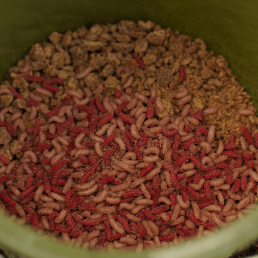
STEP 2
Add the same amount of maggots as crumb to the mix.

STEP 3
Add a small palm full of Betaine Powder to the maggot and crumb.

STEP 4
Take a few scoops of Manilla Active crumb and add to a bucket.

STEP 5
Add the same amount of maggots as crumb to the mix.

THE FINISHED MIX



STEP 1
Take a few scoops of Manilla Active crumb and add to a bucket.
STEP 2
Add the same amount of maggots as crumb to the mix.
STEP 3
Add a small palm full of Betaine Powder to the maggot and crumb.



STEP 4
Take a few scoops of Manilla Active crumb and add to a bucket.
STEP 5
Add the same amount of maggots as crumb to the mix.
THE FINISHED MIX
JIM'S TOP TIPS

TIP 1
I like to use a variety of 12mm and 16mm Manilla Active to create my crumb, this creates varied sizes when chopped.

TIP 2
I prefer to crumb my boilies at home and bring them in sealed bags during the session, it saves me time on the bank.

TIP 3
The mix stands out on the bottom, not only by it’s smell, but also its contrasting colour.

TIP 4
Adding maggots to your mix with provoke an instant feeding response, even in sub-zero conditions.


TIP 1
I like to use a variety of 12mm and 16mm Manilla Active to create my crumb, this creates varied sizes when chopped.
TIP 2
I prefer to crumb my boilies at home and bring them in sealed bags during the session, it saves me time on the bank.


TIP 3
The mix stands out on the bottom, not only by it’s smell, but also its contrasting colour.
TIP 4
Adding maggots to your mix with provoke an instant feeding response, even in sub-zero conditions.


With the sudden activity in the area, the fish obviously shied away from the spot for the rest of the evening and night. I knew the venue was known to throw up daytime bites, with bites coming through darkness being a very rare occurrence. With that, I ensured the rods were re-done with fresh Mulbz and maggots in readiness for the morning. Like clockwork, the following morning came, and the first rod was away, resulting in a 26lb common, followed by a 27lb common after re-casting the very same rod! The fish had clearly found the bait on that shingly spot irresistible, and with each capture, a few more spombs of bait were deployed to keep them grubbing and looking for more.
Unfortunately, that run of fish came to an end when I managed to catch a pike and tench, which seemed to kill the activity for the day, but I certainly wasn’t complaining. I still had one night left to go, and I repeated the previous routine of baiting and ensuring everything was as perfect as can be. The final morning saw me land the biggest of the trip, a real brute of a fish sporting its winter colours at 36lb.
Overall, it was a crazy session with a really good stamp of carp. By putting in a little more time and effort to build the picture before committing to a longer session really payed off when times were at their hardest.

